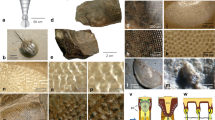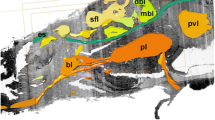Summary
-
1.
We used in vivo optical techniques to study compound eye organisation and the extent of eye stalk development in 17 species of semi-terrestrial crabs (Brachyura).
-
2.
‘Narrow-fronted’ species (Ocypodidae, Mictyridae) which have their eyes close together on elongated, vertically oriented eye stalks have a narrow acute zone for vertical resolving power along the horizon (Figs. 2, 4, 6), while ‘broad-fronted’ species (Grapsidae, Xanthidae, Portunidae) which have their eyes far apart on short eye stalks lack this specialisation (Figs. 3, 4, 6).
-
3.
There is no pronounced acute zone for horizontal resolving power in either ‘type’ of crab (Fig. 5).
-
4.
A quantitative comparison of different species shows that acute zones for vertical resolving power are closely associated with long eye stalks (Fig. 6).
-
5.
In contrast to ‘broad-fronted’ species, ‘narrow-fronted’ species are known to inhabit relatively flat terrains. We show that elongated eye stalks and acute zones for vertical resolving power are specific adaptations to the problems of spatial vision in a flat environment and could enable animals to gain depth and size information monocularily from retinal position and retinal size alone (Figs. 8, 9).
-
6.
We discuss the preconditions of spatial vision in differently structured environments and how they might have shaped the evolution of different designs of visual systems in semi-terrestrial crabs.
Similar content being viewed by others
References
Alexander SJ, Ewer DW (1969) A comparative study of some aspects of the biology and ecology ofSesarma catenata Ort. andCyclograpsus punctatus M. Edw., with additional observations onSesarma meinerti DeMan. Zool Afr 4:1–35
Bäuerlein R (1969) Morphophysiologische Untersuchungen zum Sehvermögen vonPotamon potamios rhodium Parisi (Decapoda, Potamonidae). Forma et Functio 1:285–331
Barnes RSK (1967) The Macrophthalminae of Australasia; with a review of the evolution and morphological diversity of the type genusMacrophthalmus (Crustacea: Brachyura). Trans Zool Soc Lond 31:195–262
Barnes RSK (1968) On the evolution of elongated ocular peduncles in the Brachyura. System Zool 17:182–187
Bowman TE (1984) Stalking the wild crustacean: The significance of sessile and stalked eyes in phylogeny. J Crustacean Biol 4:7–11
Brooke M de L (1981) Size as a factor influencing the ownership of copulation burrows by the ghost crab (Ocypode ceratophthalmus). Z Tierpsychol 55:63–78
Brown KT (1969) A linear area centralis extending across the turtle retina and stabilised to the horizon by non-visual cues. Vision Res 9:1053–1062
Collett TS, Harkness LIK (1982) Depth vision in animals. In: Ingle DJ, Goodale MA, Mansfield RJW (eds) Analysis of visual behavior. MIT Press, Cambridge MA London, pp 111–177
Crane (1975) Fiddler crabs of the world. Princeton Univ Press, Princeton, New Jersey
Cronin TW (1986) Optical design and evolutionary adaptation in crustacean compound eyes. J Crustacean Biol 6:1–23
Greenspan BN (1980) Male size and reproductive success in the communal courtship system of the fiddler crabUca rapax. Anim Behav 28:387–392
Hagen HO von (1967) Nachweis einer kinästhetischen Orientierung beiUca rapax. Z Morphol Ökol Tiere 58:301–320
Hagen HO von (1970) Zur Deutung langstieliger und gehörnter Augen bei Ocypodiden (Decapoda, Brachyura). Forma et Functio 2:13–57
Hagen HO von (1977) The tree-climbing crabs of Trinidad. Studies on the fauna of Curacao and other Caribbean islands 54:25–59
Herrnkind WF (1983) Movement patterns and orientation. In: Vernberg FJ, Vernberg WB (eds) The biology of Crustacea. Vol 7: Behaviour and ecology. Academic Press, New York London, pp 41–105
Hiatt RW (1948) The biology of the lined shore crab,Pachygrapsus crassipes Randall. Pacific Sci 2:135–213
Horridge GA (1978) The separation of visual axes in apposition compound eyes. Philos Trans R Soc Lond B 285:1–59
Hughes A (1975) A comparison of retinal ganglion cell topography in the plains and tree kangaroo. J Physiol (Lond) 244:61–63P
Hughes A (1977) The topography of vision in mammals. In: Crescitelli F (ed) The visual system of vertebrates (Handbook of sensory physiology vol VII/5). Springer, Berlin Heidelberg New York, pp 613–756
Kramer P (1967) Beobachtungen zur Biologie und zum Verhalten der KlippenkrabbeGrapsus grapsus L. (Brachyura: Grapsidae) auf Galapagos und am ecuadorianischen Festland. Z Tierpsychol 24:385–402
Kunze P (1967) Histologische Untersuchungen zum Bau des Auges vonOcypode cursor (Brachyura). Z Zellforsch 82:466–478
Land MF (1981) Optics and vision in invertebrates. In: Autrum H (ed) Comparative physiology and evolution of vision in invertebrates. (Handbook of sensory physiology, vol VII/ 6B) Springer, Berlin Heidelberg New York, pp 471–592
Land MF (1984) Crustacea. In: Ali MA (ed) Photoreception and vision in invertebrates. Plenum Press, New York, pp 401–438
Land MF, Eckert H (1985) Maps of the acute zones of fly eyes. J Comp Physiol A 156:525–538
Linsenmair KE (1967) Konstruktion und Signalfunktion der Sandpyramide der ReiterkrabbeOcypode saratan Forsk. (Decapoda Brachyura Ocypodidae). Z Tierpsychol 24:403–456
Nalbach H-O (1986) Visuell ausgelöste Fluchtreaktionen bei Krabben. Verh Dtsch Zool Ges 79 (in press)
Nunnemacher RF (1966) The fine structure of optic tracts of Decapoda. In: Bernhard CG (ed) The functional organisation of the compound eye. Pergamon Press, Oxford, pp 363–376
Poggio GF, Poggio T (1984) The analysis of stereopsis. Annu Rev Neurosci 7:379–412
Rossel S (1986) Binocular spatial localization in the praying mantis. J Exp Biol 120:265–281
Sandeman DC (1978) Regionalization in the eye of the crabLeptograpsus variegatus: Eye movements evoked by a target moving in different parts of the visual field. J Comp Physiol 123:299–306
Schwind R (1978) Visual system ofNotonecta glauca: A neuron sensitive to movement in the binocular visual field. J Comp Physiol 123:315–328
Schwind R (1980) Geometrical optics of theNotonecta eye: Adaptations to optical environment and way of life. J Comp Physiol 140:59–68
Schwind R (1985) Sehen unter und über Wasser, Sehen von Wasser. Naturwissenschaften 72:343–352
Snyder AW, Bossomaier TR, Hughes A (1986) Optical image quality and the cone mosaic. Science 231:499–501
Stavenga DG (1979) Pseudopupils of compound eyes. In: Autrum H (ed) Vision in invertebrates (Handbook of sensory physiology vol VII/6A) Springer, Berlin Heidelberg New York, pp 357–439
Thiele H (1971) Über die Facettenaugen von land — und wasserbewohnenden Crustaceen. Z Morphol 69:9–22
Wehner R (1981) Spatial vision in arthropods. In: Autrum (ed) Vision in invertebrates (Handbook of sensory physiology vol VII/6C) Springer, Berlin Heidelberg New York, pp 287–616
Author information
Authors and Affiliations
Rights and permissions
About this article
Cite this article
Zeil, J., Nalbach, G. & Nalbach, H.O. Eyes, eye stalks and the visual world of semi-terrestrial crabs. J. Comp. Physiol. 159, 801–811 (1986). https://doi.org/10.1007/BF00603733
Accepted:
Issue Date:
DOI: https://doi.org/10.1007/BF00603733




